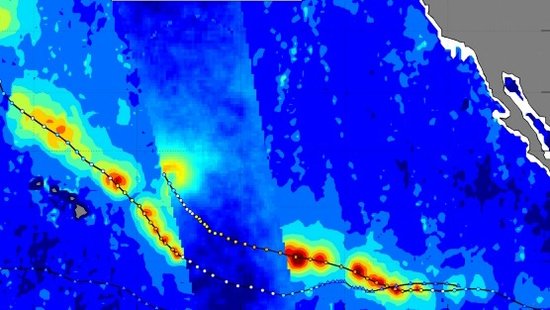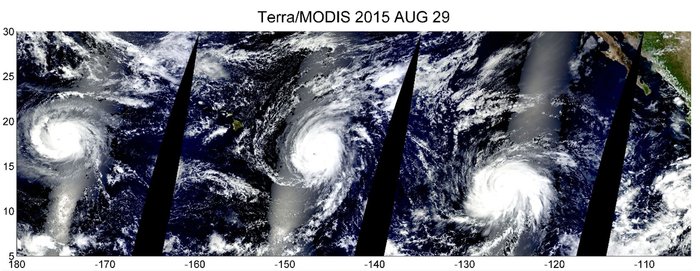SMOS radio telescope to gather information on surface winds evolvement in hurricane systems

ESA’s Soil Moisture Ocean Salinity (SMOS) Earth Explorer radio telescope and two other satellites are gathering data focused on answering the questions about how surface winds evolve under tropical storm clouds in the Pacific Ocean. New information could prove useful in predicting extreme weather events at sea.
The information about the wind speed at the ocean surface in the tropical cyclone systems is crucial in predicting marine weather, wave heights and the potential storm paths, so that adequate warning of danger can be issued on time.
The microwave detector on SMOS yields information on soil moisture and ocean salinity, however, this time, ESA upgraded the application of SMOS measurements to study wind speeds over the ocean. In the course of research, measurements from two other NASA's satellites, will be used in parallel to SMOS information to explore new information about surface winds under hurricanes.
A time-series mosaic of surface wind speed measurements under Hurricanes Kilo, Ignacio and Jimena. Data from three satellite microwave radiometer missions (ESA's L-band SMOS, NASA's L-band SMAP and Japan's C-band AMSR-2) are combined to reveal the track of each hurricane and maximum wind speed measured by each sensor at the ocean surface. Video credit: Ifremer – N. Reul, J. Tenerelli & E. Zabolotskikh/ESA SMOS+STORM project.
By combining the data in this way, a unique perspective on how the surface wind speeds evolve under tropical storms will be gained in previously unseen details. This will add to understanding the initial conditions of tropical cyclones fed into weather forecasting, and into their prediction.
Scientists from Ifremer in France and the Met Office in the UK are currently assessing these new data and how they could be integrated into hurricane forecasting, ESA announced on September 30, 2015.


Hurricanes Kilo, Ignacio and Jimena. Image credit: NASA Terra/MODIS
NASA's Terra satellite has captured a collage of the Kilo, Ignacio and Jimena hurricane trio. Sea surface temperature measurements conducted have revealed cold-water wakes trailing the three recent hurricanes, highlighting the importance of understanding the role these powerful winds have in stirring up the upper ocean and carrying cold water masses to the surface.


Hurricanes change temperature of sea surface. Copyright: Ifremer–N. Reul/ESA SMOS+STORM project and REMSS
Interactions between the sea and atmosphere on this scale have implications for hurricane forecasting centers and for ocean forecasting systems such as Europe’s Copernicus Marine Environmental Monitoring Service.
“In addition to improving marine forecasting, the combination of data from sensors on different satellites will definitively enhance our understanding of ocean–atmosphere interactions in intense storms. Yet the future of this type of satellite measurement remains uncertain, as follow-on missions are not guaranteed,” Nicolas Reul from Ifremer said.
“Highlighting the societal benefits of new measurement approaches and Earth observation technologies is part of our core business. The exciting results emerging from this project demonstrate the importance of passive microwave sensors for extreme weather prediction and for understanding air–sea interactions, and the need to study future mission concepts that combine different microwave channels on a single satellite,” Craig Donlon, ESA’s ocean scientist, added.
Source: ESA
Featured image: A time-series mosaic of surface wind speed measurements under Hurricanes Kilo, Ignacio and Jimena. Data from three satellite microwave radiometer missions (ESA's L-band SMOS, NASA's L-band SMAP and Japan's C-band AMSR-2) are combined to reveal the track of each hurricane and maximum wind speed measured by each sensor at the ocean surface. Video credit: Ifremer – N. Reul, J. Tenerelli & E. Zabolotskikh/ESA SMOS+STORM project.

Commenting rules and guidelines
We value the thoughts and opinions of our readers and welcome healthy discussions on our website. In order to maintain a respectful and positive community, we ask that all commenters follow these rules:
We reserve the right to remove any comments that violate these rules. By commenting on our website, you agree to abide by these guidelines. Thank you for helping to create a positive and welcoming environment for all.